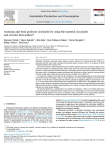Tetteh H., Balcells M., Bala A., Fullana-i-Palmer P., Margallo M., Aldaco R., Puig R. (2025). Assessing agri-food products circularity by using the material circularity and circular flow indices. Sustainable Production and Consumption, 01/07/2025, vol. 57, p. 246-261.
https://doi.org/10.1016/j.spc.2025.05.017
https://doi.org/10.1016/j.spc.2025.05.017
| Titre : | Assessing agri-food products circularity by using the material circularity and circular flow indices (2025) |
| Auteurs : | H. Tetteh ; M. Balcells ; A. Bala ; P. Fullana-i-Palmer ; M. Margallo ; R. Aldaco ; R. Puig |
| Type de document : | Article |
| Dans : | Sustainable Production and Consumption (vol. 57, July 2025) |
| Article en page(s) : | p. 246-261 |
| Langues : | Anglais |
| Langues du résumé : | Anglais |
| Catégories : |
Catégories principales 10 - INDUSTRIES ; 10.2 - IAA (en général)Thésaurus IAMM SYSTEME AGROALIMENTAIRE ; PRODUIT ALIMENTAIRE ; ECONOMIE CIRCULAIRE |
| Résumé : |
Enhancing circularity in agri-food systems improves resource efficiency by reducing inputs like fertilisers or pesticides, and food waste, while lowering environmental impacts. However, there is no consensus on which circularity indicators best suit this sector.
This study is the first to jointly apply the Material Circularity Indicator (MCI) and Circular Flow Index (CFI) to assess the circularity of a biological product, chicken meat. They were selected for their complementarity: MCI provides a broader assessment of material efficiency, considering recycled content and recycling rate of products and wastes, while CFI emphasises internal recirculation and closed-loop recycling. Therefore, sourcing chicken feed and reusing manure within the same farm increases circularity scores under CFI. The study also compares for the first time the circularity of two meat packaging systems with varying shelf lives and food waste percentages: System A (15-day shelf life, 15 % food waste) compared to System B (6-day shelf life, 47 % food waste). Results show that only MCI captured the significant difference in food waste (15 % vs. 47 % food waste) when product lifetimes were integrated into its utility factor. This highlights MCI's sensitivity to product longevity. Integrating carbon footprint measurement further revealed significant environmental differences between the two systems, underlining the need to combine circularity indicators with life cycle-based indicators for better decision-making. The proposed framework—combining MCI, CFI, and life cycle indicators—offers a more holistic approach to measuring circularity in biological systems. Further research is recommended to test new case studies and adapt existing circularity indicators. The goal is to establish a small, user-friendly set of complementary indicators tailored to the agri-food sector's unique challenges, thereby supporting more circular practices. |
| Cote : | En ligne |
| URL / DOI : | https://doi.org/10.1016/j.spc.2025.05.017 |







